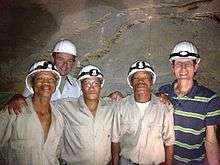Tracking in Caves

Tracking in Caves is an international archaeology project focusing on reading and understanding human tracks in archaeological contexts. The project combines Western scientific approaches with the indigenous knowledge of present-day trackers from hunter-gatherer societies.
Foundation
Tracking in Caves was organized as a joint project by the African Archaeology (at the Institute of Prehistoric Archaeology, University of Cologne),[1] the Neanderthal Museum, the Heinrich-Barth-Institute, the Nyae Nyae Conservancy, the Kalahari Peoples Fund and the Association Louis Bégouën. Financial support came from the German Research Foundation Deutsche Forschungsgemeinschaft.

The numerous human footprints still preserved in some rock art caves in southern France were the starting point of the project. These tracks date back to the last Ice Age and originated around 17,000 years ago. In contrast to the rock art, they have so far only been sparsely studied and with purely morphometric, "surveying" approaches. In order to get a deeper understanding of these very individual human traces, two researchers, Tilman Lenssen-Erz (University of Cologne, African Archaeology),[2] and Andreas Pastoors (Neanderthal Museum, Mettmann),[3] invited African trackers to support them. Together with /Ui /Kxunta, /Ui G/aqo De!u and Tsamkxao Ciqae, three highly specialized trackers of the Ju/'hoansi San in Namibia, they investigated various caves in the French Pyrenees in the summer of 2013, including Niaux, Pech-Merle, Fontanet and Tuc d'Audoubert.[4] In all the track fields that were investigated the three San experts were able to determine the age, sex, gait and occasional peculiarities (load, slipping, etc.) of most people who had moved there.[5] Concluding statements on the prehistoric footprints were made after intensive discussion in the consensus of all three trackers. These conversations were recorded for further evaluation. The project was also accompanied by a film team and the resulting 90 minute TV documentary was broadcast on Arte TV on September 6, 2014.[6] In addition to this documentary the project reached a far ranging public also in the following years in particular through media reports in newspapers and journals.[7]
In 2014, with the support of AICON 3D Systems, the footprint field in Pech-Merle was scanned, which had been examined by the trackers the year before.[8]
Presentation of findings

In 2015, the core research team travelled back to Namibia, funded by the Andrea von Braun Stiftung. There the English dubbed version of the TV documentary was screened at the communities of the participant San trackers at various locations in Namibia and Botswana. On these occasions the three trackers took over the entire presentation (introduction, explanations and subsequent discussion) of the events. In addition to the "homecoming" of the results, an important element of these movie nights was the conveyance of the importance of the art of tracking based on the encyclopaedic ecological knowledge of the communities.
In order to bring together the very diverse approaches existing worldwide in the field of tracking and in scientific research on old tracks, an international conference is scheduled for Cologne and Mettmann (Neanderthal Museum) in May 2017. It allows an intensive exchange between scientists and trackers from different parts of the world, in order to bring together the wide and most diverse knowledge about prehistoric tracks and their interpretation. A wide range of indigenous knowledge is to be articulated through trackers from such diverse environments as arid tropical zones, rainforest and Arctic tundra.
References
- ↑ "Start". Retrieved 26 January 2017.
- ↑ "Dr. Tilman Lenssen-Erz". Retrieved 26 January 2017.
- ↑ "PD Dr. habil. Andreas Pastoors – Institut für Ur- und Frühgeschichte". Retrieved 26 January 2017.
- ↑ "DFG – Deutsche Forschungsgemeinschaft – „Hauptsache Spur"– Afrikanische Buschleute untersuchen französische Steinzeithöhlen". Retrieved 26 January 2017.
- ↑ Pastoors, Andreas; Lenssen-Erz, Tilman; Ciqae, Tsamkxao; Kxunta, Ui; Thao, Thui; Bégouën, Robert; Biesele, Megan; Clottes, Jean (1 August 2015). "Tracking in Caves: Experience Based Reading of Pleistocene Human Footprints in French Caves". 25 (3): 551–564. doi:10.1017/S0959774315000050. Retrieved 26 January 2017 – via Cambridge Core.
- ↑ websolutions, hinterhof. "[ Paolo-Film ] – Fußspuren in die Vergangenheit". Retrieved 26 January 2017.
- ↑ „Hauptsache Spur“– Afrikanische Buschleute untersuchen französische Steinzeithöhlen.
- ↑
Further reading
- Andreas Pastoors, Tilman Lenssen-Erz, Tsamkgao Ciqae, Ui Kxunta, Thui Thao, Robert Bégouën, Megan Biesele & Jean Clottes (2015) Tracking in Caves – Experience based reading of Pleistocene human footprints in French caves. Cambridge Archaeological Journal, 25(3): 551-564.
- Andreas Pastoors, Tilman Lenssen-Erz, Bernd Breuckmann, Tsamkxao Ciqae, Ui Kxunta, Dirk Riepe-Zapp, Thui Thao (2016) Experience based reading of Pleistocene human footprints in Pech-Merle. Quaternary International, 21 March 2016
External links
Media coverage
- Süddeutsche Zeitung, 17. Juli 2013, p. 16, Marc von Lüpke "Die Barfuß-Forscher"
- NRC – Handelsblad, 18. Juli 2013, Theo Toebosch "De jacht op prehistorische voetsporen"
- Science, 26 July 2013, Vol 341, p. 326 "Modern Trackers Decipher Ancient Footsteps"
- New Scientist, 21/28 December 2013, pp. 64–66, Christopher Kemp "Walking with Cavemen"
- Bild der Wissenschaft, 7-2014, pp. 56–63, Karin Schlott "Fährtenleser auf der Spur unserer Urahnen"
- Pyrénées Magazine, no 157, 01/02-2015, p. 10, Natacha Scheidhauer-Fradin "Des Bochimans sur les pas des hommes préhistoriques"
- Archäologie in Deutschland, 4-2015, pp. 14–19, Tilman Lenssen-Erz & Andreas Pastoors "Fährtenleser blicken 17000 Jahre in die Vergangenheit"
- Peolwane, May 2015, pp. 22–25, Phillip Segadika "Decoding Messages from the Distant Past"
- Die Zeit, 21.Mai 2015, pp. 33–35, Urs Willmann & Andreas Derebucha "Spurensuche in der Steinzeit"
- Geo-Magazin, 6-2015, pp. 44–58, Jörg Uwe Albig & Anastasia Taylor-Lind "Im Licht der Jäger"
- Express, 16 August 2015, p. 8, S. Wildermann "Führen Fährtenleser die Forscher zum Ur-Fußabdruck?"